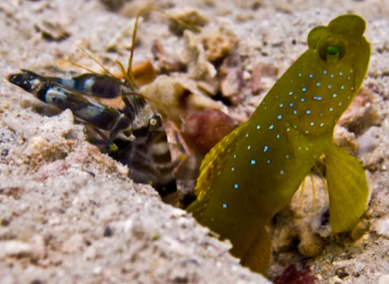 |
| Figure 1. Goby fish/shrimp pair sit in alert poses. source |
While the understanding of how the
goby and shrimp pair up is limited, many studies have been conducted in the
wild to evaluate trends between pairings. Most pairings are observed in
locations relatively close to reefs. A statistical analysis conducted in the
Red Sea examined 750 burrows inhabited by goby/shrimp pairs. The pairs were evaluated
on a vertical and horizontal scale based on the location and composition of
their burrows. This study discovered that the shallower the water and the
closer the burrow was to the reef, the pairings had higher specifications for
partner selection (Karplus 1981). Gobies chose shrimp based on type of sediment
used (fine, coarse or intermediate) to form the burrows and the burrows’
proximity to the reef. Deeper water gobies and shrimp lacked the complexity
based on burrow composition in selection, which was hypothesized due to the
decrease is sediment variation (Karplus 1981). While this study did not
entirely solve the mechanism behind the pairing as it excluded behavioral
characteristics, it did further establish the complexity of the relationship.
Other studies have mentioned gobies making selection of shrimp based on
coloration or chemical discharges (Preston 1978). It can be safe to say that
the selection of pairs is obviously dependent on many variables to properly
combat the environment at which the pair is located. Once a pair is finally
together the mutualist relationship can begin and the interspecies
communication can be observed.
Communication can be described as an
exchange of information translated between a sender and a receiver. The goby
and shrimp pair is one of the few examples of interspecies communication used
for mutual survival (Preston 1987). It is understood that the blind shrimp uses
the goby as a seeing-eye dog. While their communication to achieve this is
complex, it does not start out as such. The two develop their communication as
soon as the goby enters an available burrow. Once the pair begins their
relationship, the goby stands at either the opening of the burrow or on top of
the burrow carefully keeping alert for predators or rival gobies. The shrimp
approaching the entrance of the burrow will use its longest antennae to reach
for the goby’s caudal fin, where it will remain in contact while exiting the
burrow. It is through this connection that the pair communicates (Preston 1987).
The goby communicates the perceived
danger through dorsal fin extension, a variety of tail flicks, and sand
nibbling. These actions are all interpreted by the shrimp through the antennae
connection. If a signal for danger is sent, the shrimp will either “sit” or
“flee”. “Sitting” in conjunction to the still goby can boost each other’s
camouflage (Preston 1987). However, if the danger is too threatening, the
shrimp will retreat into the burrow and the goby will follow. The goby always
enters after the shrimp, never before. It is the goby who exits the burrow
post-fleeing to determine if the danger is gone and will signal to the shrimp to
commence excavation of their burrow. This communication is special for the
pair, as gobies only alert for danger when a shrimp is present (Preston 1987).
This tactile method allows the goby to focus on spotting incoming dangers.
While the main form of communication between the two is tactile, there have
also been suggested forms of chemical and visual communication (Preston 1987).
 |
| Figure 2. Goby and shrimp sitting at entrance of burrow. Source. |
The symbiotic relationship between
these creatures is clearly beneficial as it remains within each other’s
evolutionary lineages. There are roughly 120 species of gobies that illustrate
an obligate mutualistic association with a burrow-dwelling shrimp (Thacker 2011).
Through phylogenetic studies of the gobies and shrimp it has become clear that
this mutualistic relationship has evolved twice. The occurrence of this
association increases the fitness of both the goby and shrimp. This
relationship though only occurs during the adult phase for both shrimp and
goby. In studies without burrowing shrimp present gobies have higher rates of
mortality without the hide. Similarly, shrimp without a goby have a noticeably
slower rate of growth and excavating capabilities. However, when together the
goby receives a protective burrow at night and the shrimp receives protection
during the day, dually increases each other’s survivability (Thacker 2011).
These boosts in protection allow both to thrive without having to expend energy
on protection and redirect their energy to either excavating or guarding.
This mutualistic symbiotic
relationship can base its success due to the rare interspecies communication
seen between the several species of gobies and Alpheus shrimp that live near
reefs. It is obvious that both the goby and shrimp, once in its respective
adult phase, have a higher survivability together as this association has
occurred twice in their evolutionary lineages. Through this association
individually they can spend their available energy in a way that boosts their
collective productivity to ensure survival. It is for these reasons that the
goby and shrimp are such a unique partnership.
References
Karplus, I., R.
Szlep, and T. M. 1981. Goby-shrimp partner specificity. I. Distribution in the
northern Red Sea
and partner specificity. Journal of Experimental Marine Biology and Ecology
51(1):1–19.
Preston, J. 1978.
Communication systems and social interactions in a goby-shrimp symbiosis.
Animal Behaviour 26:791–802.
Thacker, C. E., A. R.
Thompson, and D. M. Roje. 2011. Phylogeny and evolution of Indo-Pacific shrimp-associated gobies (Gobiiformes:
Gobiidae). Molecular Phylogenetics and Evolution 59(1):168-176.



No comments:
Post a Comment